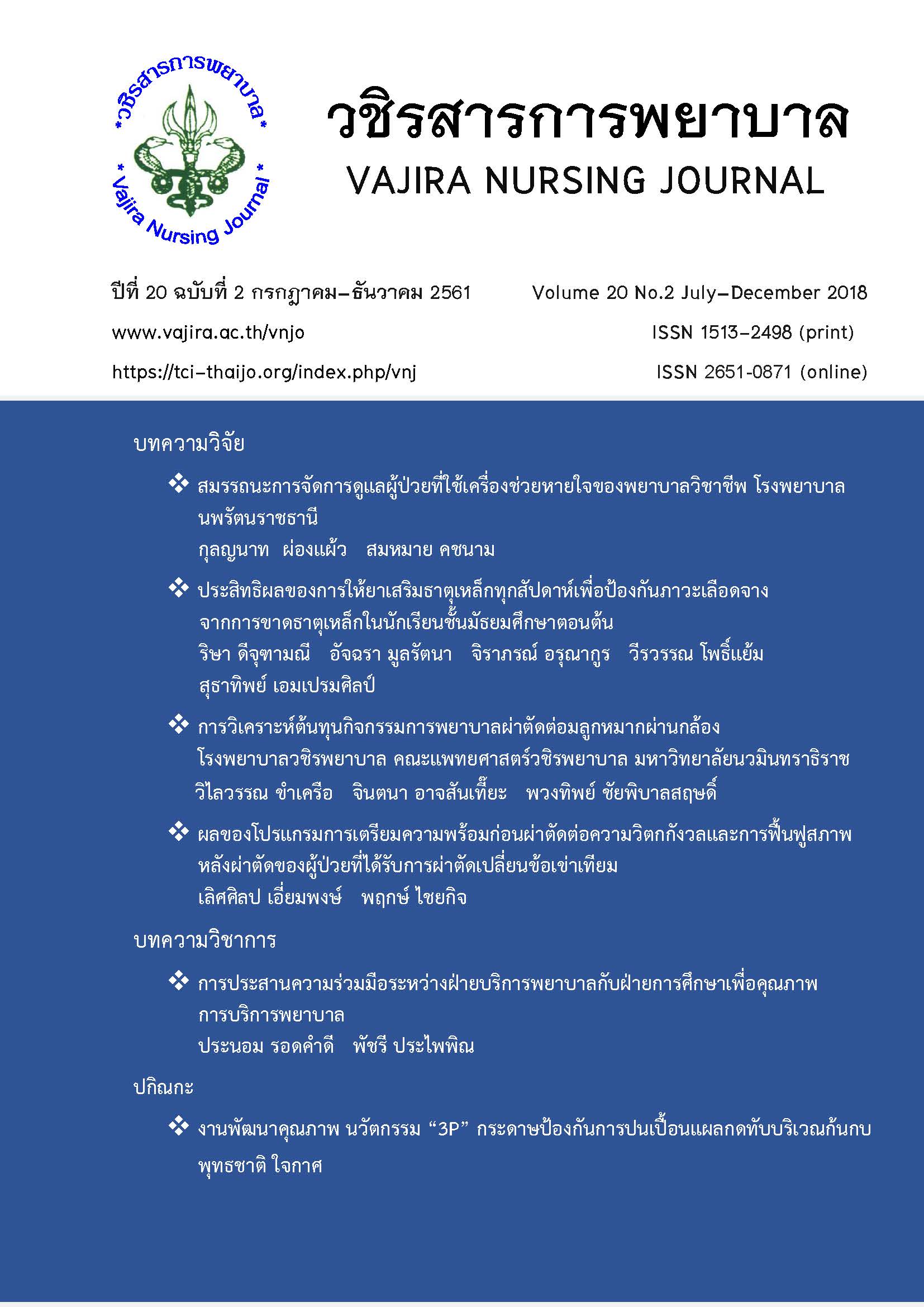Effectiveness of weekly iron supplementation to prevent iron deficiency anemia in secondary school students.
Main Article Content
Abstract
This research is designed as the quasi-experimental study for pre-post measurement. The objective of study is to investigate the effectiveness of weekly iron supplementation to
prevent iron anemia deficiency in secondary school students. Therefore samples of study were 7th grade students at one high school in Bangkok. The sample size was 116 particularly. They obtained the knowledgeable brochures and got a tablet of iron supplement at 60 mg per week along 3 months since January 2017. The instruments of this study comprise the core brochure, as the topic of “Anemia prevention in school-aged children” which published by department of Health, ministry of public health collaborated with Faculty of Medicine Ramathibodi hospital, Mahidol university and hemoglobin tester & analyzer, namely as HemeCue Hb 201+. Statistical analysis described by percentages, mean and standard deviation and compared the prevalence difference for implying the effectiveness of weekly iron supplementation with Chi-Square and nonparametric. The results showed that the prevalence of anemia after taking iron supplement (26.7%) had lower rate than before the supplement (37.9%), significantly decreasing 11.2 percentage (p-value=0.029).
Article Details
เนื้อหาและข้อมูลในบทความที่ลงตีพิมพ์ในวชิรสารการพยาบาลถือเป็นข้อคิดเห็นและความรับผิดชอบของผู้เขียนบทความโดยตรง ซึ่งกองบรรณาธิการไม่จำเป็นต้องเห็นด้วย หรือร่วมรับผิดชอบใด ๆ ทั้งสิ้น
บทความ ข้อมูล เนื้อหา รูปภาพ ฯลฯ ที่ได้รับการตีพิมพ์ในวชิรสารการพยาบาล ถือเป็นลิขสิทธิ์ของวชิรสารการพยาบาล หากบุคคลใดหรือหน่วยงานใดต้องการนำทั้งหมดหรือส่วนหนึ่งส่วนใดไปเผยแพร่ต่อหรือเพื่อกระทำการใด ๆ จะต้องได้รับอนุญาตเป็นลายลักอักษรจากวชิรสารการพยาบาลก่อนเท่านั้น
References
http://www.si.mahidol.ac.th/sidoctor/e-pl/articledetail.asp?id=850.
วันชัย วนะชิวนาวิน. (2559). ค้นหาปัจจัยเสี่ยงเพื่อวินิจฉัยภาว โลหิตจางจากการขาดธาตุเหล็ก. วารสารโลหิตวิทยาและเวชศาสตร์บริการโลหิต, 26(1), 7-8.
สำนักโภชนาการ กรมอนามัย กระทรวงสาธารณสุข. (2546a). รายงานการสำรวจภาวะอาหารและโภชนาการของประเทศไทย ครั้งที่ 5 พ.ศ. 2546. กรุงเทพ: โรงพิมพ์องค์การรับส่งสินค้าและพัสดุภัณฑ์.
สำนักโภชนาการ กรมอนามัย กระทรวงสาธารณสุข. (2546b). การดำเนินงานการควบคุมและป้องกันโลหิตจางจากการขาดธาตุเหล็ก. สืบค้นจาก http://nutrition.anamai.moph.go.th/images/file/การดำเนินงานการควบคุมและป้องกันโลหิตจางจากการขาดธาตุเหล็ก%20(webboard).pdf.
สำนักโภชนาการ กรมอนามัย กระทรวงสาธารณสุข. (2556). คู่มือแนวทางการควบคุมและป้องกันโลหิตจางจากการขาดธาตุเหล็ก. นนทบุรี: สำนักโภชนาการ กรมอนามัย กระทรวงสาธารณสุข.
สำนักโภชนาการ กรมอนามัย กระทรวงสาธารณสุข. (2560). คู่มือการให้ยาเสริมธาตุเหล็ก โครงการสนับสนุนการเข้าถึงบริการอนามัยโรงเรียน โดยความร่วมมือขององค์กรปกครองส่วนท้องถิ่น. นนทบุรี: กรมอนามัย กระทรวงสาธารณสุข.
สุริยะเดว ทรีปาติ, และวิมลทิพย์ มุกสิกพันธ์. (2556). คุณภาพชีวิตเด็ก 2556. สมุทรสาคร: โรงพิมพ์แอ๊ปป้า
พริ้นติ้ง กรุ๊ป จำกัด.
De-Regil, L. M., Jefferds, M. E., Sylvetsky, A. C., & Dowswell, T. (2011). Intermittent iron supplementation for improving nutrition and development in children under 12 years of age. Cochrane Database Syst Rev, doi:10.1002/14651858.CD009085.pub2.
World Health Organization. (2001). Iron Deficiency Anaemia Assessment, Prevention and Control A guide for programme managers. Geneva: World Health Organization.

